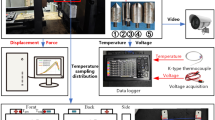Abstract
External short circuit has a severe influence on lithium battery’s performance. Currently, a huge study has focused on the single battery’s short circuit. However, cells are often interconnected into a module in real applications. There are many possibilities that external short circuit of a single cell has huge impact on the other cells in a battery module. In this research, experiments were conducted under different conditions (single lithium-ion battery, 3 lithium-ion battery modules, 9 lithium-ion battery modules) at different ambient temperatures (30, 40, and 50 °C) and different state of charge [SOCs (80%, 90%, 100%)] The temperature of the battery surface (positive electrode, middle) rose during external short circuit. The variation of the battery temperature was analyzed. Then, the variation of battery performance parameters under external short circuit conditions was studied. All lithium-ion batteries were divided into two groups, one being an external short circuit and the other being not short-circuited externally. As a result, when the lithium-ion battery was short-circuited externally, the battery temperature rose rapidly to the maximum temperature that the battery can rise. The highest temperature caused by external short circuit appeared in the case of a single battery. The higher the SOC, the faster the battery temperature rose. In the cycle charge and discharge, the rate of decay of the battery after an external short circuit was twice faster than that of a normal battery. As the temperature increased, the rate of battery capacity decayed further. Under normal circumstances, the attenuation of the battery to 80% required about 350 cycles. The life of the battery after the external short circuit was shortened by more than half, and when the temperature rises, even only about 100 cycles were required.








Similar content being viewed by others
References
Feng X, Weng C, Ouyang M, Sun J. Online internal short circuit detection for a large format lithium ion battery. Appl Energy. 2016;161:168–80.
Kriston A, Pfrang A, Döring H, Fritsch B, Ruiz V, Adanouj I, Kosmidou T, Ungeheuer J, Boon-Brett L. External short circuit performance of graphite-LiNi1/3Co1/3Mn1/3O2 and graphite-LiNi0.8Co0.15Al0.05O2 cells at different external resistances. J Power Sources. 2017;361:170–81.
Dubaniewicz TH, Ducarme JP. Internal short circuit and accelerated rate calorimetry tests of lithium-ion cells: considerations for methane-air intrinsic safety and explosion proof/flameproof protection methods. J Loss Prev Process Ind. 2016;43:575–84.
Feng X, Lu L, Ouyang M, Li J, He X. A 3D thermal runaway propagation model for a large format lithium ion battery module. Energy. 2016;115(1):194–208.
Giuliano MR, Advani SG, Prasad AK. Thermal analysis and management of lithium–titanate batteries. J Power Sources. 2011;196(15):6517–24.
Grzegorz P, Marongiu A, Drillkens J, Sinhuber P, Sauer D. A critical overview of definitions and determination techniques of the internal resistance using lithium-ion, lead-acid, nickel metal-hydride batteries and electrochemical double-layer capacitors as examples. J Power Sources. 2015;296:365–76.
Maleki H, Howard JN. Internal short circuit in Li-ion cells. J Power Sources. 2009;191(2):568–74.
Shriram S, Premanand R, John Z. Analysis of internal short-circuit in a lithium ion cell. J Power Sources. 2009;194(1):550–7.
Cai W, Wang H, Maleki H, Howard J, Lara-Curzio E. Experimental simulation of internal short circuit in Li-ion and Li-ion-polymer cells. J Power Sources. 2011;196(18):7779–83.
Wu MS, Chiang PCJ, Lin JC, Jan Y. Correlation between electrochemical characteristics and thermal stability of advanced lithium-ion batteries in abuse tests-short-circuit tests. Electrochim Acta. 2004;49(11):1803–12.
Acknowledgements
This work was supported by the College of Safety Science and Engineering, Nanjing Tech University, PR China and the Center for Process Safety and Disaster Prevention, Department of Safety, Health, and Environmental Engineering, YunTech, Taiwan.
Author information
Authors and Affiliations
Corresponding authors
Additional information
Publisher's Note
Springer Nature remains neutral with regard to jurisdictional claims in published maps and institutional affiliations.
Rights and permissions
About this article
Cite this article
Ji, H., Chung, YH., Pan, XH. et al. Study of lithium-ion battery module’s external short circuit under different temperatures. J Therm Anal Calorim 144, 1065–1072 (2021). https://doi.org/10.1007/s10973-020-09506-0
Received:
Accepted:
Published:
Issue Date:
DOI: https://doi.org/10.1007/s10973-020-09506-0




